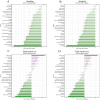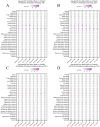Global and regional burden of nasopharyngeal cancer in older adults attributable to smoking and high alcohol use from 1990 to 2021
- PMID: 40575097
- PMCID: PMC12197913
- DOI: 10.3389/fpubh.2025.1614389
Global and regional burden of nasopharyngeal cancer in older adults attributable to smoking and high alcohol use from 1990 to 2021
Abstract
Background: Nasopharyngeal cancer (NPC) poses a considerable global health burden, with behavioral risk factors such as smoking and high alcohol use contributing to disparities across sociodemographic groups. The growing aging population faces heightened vulnerability to NPC due to prolonged exposure to these modifiable risks, yet comprehensive analyses of aging-specific burden patterns remain limited.
Methods: Utilizing the Global Burden of Disease 2021 data, we conducted a systematic evaluation of NPC burden attributable to smoking and alcohol use across 204 countries from 1990 to 2021. Age-stratified analyses focused on older adults (≥60 years), incorporating three analytical dimensions: Sociodemographic Index (SDI) quintiles, sex-specific disparities, and geospatial heterogeneity. Age-standardized mortality (ASMR) and age-standardized DALY rates (ASDRs) were calculated with 95% uncertainty intervals. Temporal trends were quantified via estimated annual percentage changes (EAPCs). Bayesian age-period-cohort modeling projected disease burden through 2050.
Results: From 1990 to 2021, smoking and high alcohol use contributed substantially to the NPC burden globally, with older adults exhibiting distinct risk profiles. Decline in smoking-related burden in global ASDR was observed, yet older adults in low and middle SDI regions retained disproportionately high rates. Rise in alcohol-related burden in certain regions (e.g., Southeast Asia and Caribbean) was particularly pronounced among older age groups. Middle and high-middle SDI regions consistently exhibited the highest ASDR for both risk factors, with older adults contributing a significant share of disability-adjusted life years (DALYs). Older males faced the highest DALY burdens, with extreme older male-to-female disparities persisting across age groups. Population aging will amplify absolute DALY burdens among older adults by 2050.
Conclusion: Behavioral risk factors such as tobacco and alcohol use remain key contributors to the burden of nasopharyngeal cancer in older persons, with significant regional, gender, and demographic differences. There is an urgent need to develop targeted public health policies focusing on smoking cessation and alcohol control that take into account the health needs of older persons.
Keywords: GBD; alcohol use; healthy aging; nasopharyngeal cancer; smoking use.
Copyright © 2025 Wang, Li, Luo and Song.
Conflict of interest statement
The authors declare that the research was conducted in the absence of any commercial or financial relationships that could be construed as a potential conflict of interest.
Figures










Similar articles
-
Global burden trends and future predictions of ischemic heart disease attributable to air pollution in people aged 60 years and older, 1990-2021.Front Public Health. 2025 Jul 4;13:1598092. doi: 10.3389/fpubh.2025.1598092. eCollection 2025. Front Public Health. 2025. PMID: 40687134 Free PMC article.
-
The global burden of stroke attributable to high alcohol use from 1990 to 2021: An analysis for the global burden of disease study 2021.PLoS One. 2025 Jul 14;20(7):e0328135. doi: 10.1371/journal.pone.0328135. eCollection 2025. PLoS One. 2025. PMID: 40658674 Free PMC article.
-
Reducible burden of laryngeal cancer in men aged 50 and older attributable to smoking and alcohol use: insights from the global burden of disease study 2021.Front Public Health. 2025 Jun 9;13:1577138. doi: 10.3389/fpubh.2025.1577138. eCollection 2025. Front Public Health. 2025. PMID: 40552237 Free PMC article.
-
Burden of inflammatory bowel disease among elderly, 1990-2019: A systematic analysis based on the global burden of disease study 2019.Autoimmun Rev. 2025 Jan 31;24(2):103708. doi: 10.1016/j.autrev.2024.103708. Epub 2024 Nov 23. Autoimmun Rev. 2025. PMID: 39586389
-
Incentives for preventing smoking in children and adolescents.Cochrane Database Syst Rev. 2017 Jun 6;6(6):CD008645. doi: 10.1002/14651858.CD008645.pub3. Cochrane Database Syst Rev. 2017. PMID: 28585288 Free PMC article.
References
-
- Chen B, Zhan Z, Xu Y, Yu S, Huang J, Fang Y, et al. Long-term trends in the burden of nasopharyngeal carcinoma in China: a comprehensive analysis from 1990 to 2021 and projections to 2030 based on the global burden of disease study 2021. Radiother Oncol. (2025) 202:110613. 10.1016/j.radonc.2024.110613 - DOI - PubMed
-
- Salehiniya H, Mohammadian M, Mohammadian-Hafshejani A, Mahdavifar N. Nasopharyngeal cancer in the world: epidemiology, incidence, mortality and risk factors. WCRJ. (2018) 5:e1046. 10.32113/wcrj_20183_1046 - DOI
MeSH terms
LinkOut - more resources
Full Text Sources
Medical

